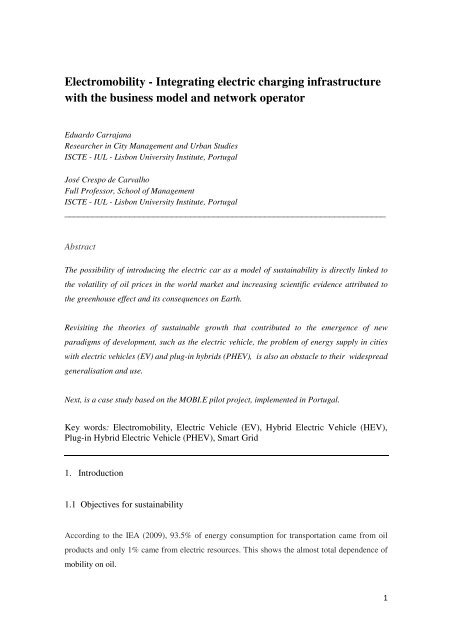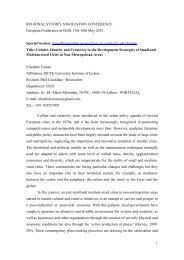Electromobility - Integrating electric charging infrastructure with the ...
Electromobility - Integrating electric charging infrastructure with the ...
Electromobility - Integrating electric charging infrastructure with the ...
You also want an ePaper? Increase the reach of your titles
YUMPU automatically turns print PDFs into web optimized ePapers that Google loves.
<strong>Electromobility</strong> - <strong>Integrating</strong> <strong>electric</strong> <strong>charging</strong> <strong>infrastructure</strong><strong>with</strong> <strong>the</strong> business model and network operatorEduardo CarrajanaResearcher in City Management and Urban StudiesISCTE - IUL - Lisbon University Institute, PortugalJosé Crespo de CarvalhoFull Professor, School of ManagementISCTE - IUL - Lisbon University Institute, Portugal_____________________________________________________________________AbstractThe possibility of introducing <strong>the</strong> <strong>electric</strong> car as a model of sustainability is directly linked to<strong>the</strong> volatility of oil prices in <strong>the</strong> world market and increasing scientific evidence attributed to<strong>the</strong> greenhouse effect and its consequences on Earth.Revisiting <strong>the</strong> <strong>the</strong>ories of sustainable growth that contributed to <strong>the</strong> emergence of newparadigms of development, such as <strong>the</strong> <strong>electric</strong> vehicle, <strong>the</strong> problem of energy supply in cities<strong>with</strong> <strong>electric</strong> vehicles (EV) and plug-in hybrids (PHEV), is also an obstacle to <strong>the</strong>ir widespreadgeneralisation and use.Next, is a case study based on <strong>the</strong> MOBI.E pilot project, implemented in Portugal.Key words: <strong>Electromobility</strong>, Electric Vehicle (EV), Hybrid Electric Vehicle (HEV),Plug-in Hybrid Electric Vehicle (PHEV), Smart Grid1. Introduction1.1 Objectives for sustainabilityAccording to <strong>the</strong> IEA (2009), 93.5% of energy consumption for transportation came from oilproducts and only 1% came from <strong>electric</strong> resources. This shows <strong>the</strong> almost total dependence ofmobility on oil.1
There are concrete objectives in some countries, as well as in <strong>the</strong> EU, geared towards tosustainable development directly related to <strong>the</strong> global greenhouse gas (GHC), and <strong>the</strong>reare several initiatives related to <strong>the</strong> ways of achieving <strong>the</strong>se objectives. One of <strong>the</strong>seobjectives relates to human mobility, in particular <strong>with</strong> <strong>the</strong> massive introduction of <strong>the</strong><strong>electric</strong> vehicle (EV) and hybrid <strong>electric</strong> vehicle (HEV). The EU has set macroeconomictargets for 2020, as per Decision 2009/406/EC and <strong>the</strong> European Directive 2009/28/ECon renewable energy.According to Master, M. (2011) “Oil industry analysts suggest <strong>the</strong> world has barrels ofcrude enough for about forty years at current rates of consumption -- long enough,surely, for <strong>the</strong> <strong>electric</strong> alternative to assume <strong>the</strong> mantle. Meanwhile sceptics argue thatreserves are far lower than <strong>the</strong> OPEC countries will ever admit and that oil prices willsoon rise sharply, long before battery technology and <strong>electric</strong> transport <strong>infrastructure</strong> issufficiently advanced.” In fact, <strong>the</strong> development of <strong>electric</strong> cars is directly linked to <strong>the</strong>evolution of oil prices along <strong>the</strong> years (Chan, 2007).Currently, and given <strong>the</strong> continued rise in oil prices, we are witnessing an increase in<strong>the</strong> concept of sustainability related to <strong>electric</strong> mobility. Agreeing <strong>with</strong> Andersen et al.(2009), Chan (2007) and Duvall (2002), <strong>the</strong> present technological concept is focused onHEV and PHEV hybrid vehicles. However, <strong>the</strong> rate of development of new solutionstargeting more efficient batteries reveals <strong>the</strong> <strong>electric</strong> vehicle (EV) potential for citytravel. At <strong>the</strong> same time that <strong>electric</strong> vehicle models are launch on <strong>the</strong> market, <strong>the</strong>re isalso technological development to deal <strong>with</strong> <strong>the</strong> several problems inherent to <strong>the</strong> <strong>electric</strong>vehicle project, particularly <strong>electric</strong>al <strong>charging</strong>. There are several pilot projects inprogress since 2008 in Israel, Denmark, Australia and <strong>the</strong> USA (California) (Andersen,Ma<strong>the</strong>ws, Rask, 2009). This article will cross-reference <strong>the</strong> existing models of <strong>electric</strong>supply and <strong>the</strong> MOBI.E project currently in <strong>the</strong> pilot stage and being implemented inPortugal since 2009 and until 2012.1.2 A concept of integrationObserving <strong>the</strong> need for a framework to integrate <strong>the</strong> element of <strong>electric</strong>al load <strong>with</strong>in abusiness model and a network of operators, this paper is based on a case study on <strong>the</strong>2
Portuguese MOBI.E solution for <strong>charging</strong> <strong>electric</strong> vehicles. It intends to respond tosome problems related to this system.There is a political issue underlying electromobility projects, both in Europe and <strong>the</strong>United States and China. The attempt to become economically independent from oil andto reduce <strong>the</strong> greenhouse effect, has led governments to seek out electromobility.However, <strong>the</strong> problems related to <strong>the</strong> dissemination of <strong>the</strong> <strong>electric</strong> vehicle are importantand specific, particularly insofar as to autonomy, price, and battery-<strong>charging</strong> time.Research in this sensitive area is constantly being redirected as scientists verify <strong>the</strong>irchances of developing new solutions. One can cite as example <strong>the</strong> existence ofultracapacitors (which store energy in charge electrodes instead of storing <strong>the</strong>electrolyte) IEA (2009) and <strong>the</strong> eventual association of lithium batteries <strong>with</strong>ultracapacitors (Chan, 2007).One of <strong>the</strong> problems of <strong>the</strong> expansion of electromobility is <strong>the</strong> lack of a network thatallows <strong>charging</strong> <strong>the</strong> <strong>electric</strong> vehicle in cities or even at home. Additionally, <strong>the</strong>problems inherent in <strong>the</strong> <strong>electric</strong>al <strong>charging</strong> are related to safety, compatibility andinteroperability.2. The analysis methodologyThe analysis methodology of this paper is related to a case study. According to Yin(2003), when <strong>the</strong>re is a single case study on a particular matter, it is deemed to be acritical case, in order to test an accepted formulation.Agreeing <strong>with</strong> Yin (2003), <strong>the</strong> presentation of <strong>the</strong> MOBI.E case will be justified byrational analysis of two characteristics that define single cases since <strong>the</strong>y are revelatorycases. This occurs when you can immediately analyse a phenomenon. The secondcharacteristic of <strong>the</strong> single case is <strong>the</strong> longitudinal case, where it is possible for <strong>the</strong> samesingle case to be studied at two different times. This study will consider a holisticdesign approach.3
The MOBI.E is a pilot project and will be studied as a pilot case study. Therefore, itrequires collecting <strong>the</strong>oretical, as well as technical information. This case study presentsa research study related to electromobility (Adene, 2010), as well as <strong>the</strong> description ofan intelligent <strong>charging</strong> system, in an open platform.To obtain evidence, interviews were conducted <strong>with</strong> supervisors of <strong>the</strong> Pilot Project,which produced both quantitative and qualitative data, through <strong>the</strong> formulation of openand closed questions. A chain of evidence was attempted, but <strong>the</strong> fact that it is a pilotproject did not allow for a concrete analysis of <strong>the</strong> consequences of <strong>the</strong> project itself.3. The case studyThis case study was selected because it represents a wager on <strong>the</strong> open platformsbusiness and, thus, represents a step forward in <strong>the</strong> development of <strong>the</strong> issue ofelectromobility - <strong>charging</strong> service for EVs or PHEVs. Interoperability is a matter ofrelevant importance and MOBI.E appears to be an integrator. It constitutes a businessmodel in itself, associated <strong>with</strong> <strong>the</strong> predictable growth of electromobility. The resolutionof this integration problem requires <strong>the</strong> interaction of several entities, whose roles arenot only regulatory but also involve <strong>the</strong> development of a prototype, cash flows,<strong>electric</strong>al software, and <strong>charging</strong> solutions. Harmonising this integral framework for <strong>the</strong><strong>electric</strong> vehicle <strong>charging</strong> system is presented as <strong>the</strong> best way to attract new users to<strong>electric</strong>al mobility.As Hajer (2011) said “The frame of <strong>the</strong> energetic society encourages governments totake a different approach, and requires <strong>the</strong> various tools already available togovernments to be used in new ways”. The initiative's pilot project MOBI.E wasestablished by <strong>the</strong> Portuguese government under <strong>the</strong> “Programme for ElectricMobility”, which is integrated in a major instrument – <strong>the</strong> “National Plan for EnergyEfficiency – Portugal 2015”, approved in 2009, <strong>with</strong> <strong>the</strong> aim of expanding <strong>the</strong> use of <strong>the</strong><strong>electric</strong> vehicle in Portugal. The pilot project MOBI.E began its development in 2008,and is a smart <strong>electric</strong>al <strong>charging</strong> solution, based on an open platform.The partnership formed between various Research and Development entities, such as RENERLiving Lab, CEIIA-CE, REMOBI, <strong>the</strong> communication entity Brandia Central, <strong>the</strong> energy entityEDP INOVAÇÃO, <strong>the</strong> software technology entities Novabase and Critical, and <strong>the</strong> technology4
entities Efacec, Siemens and Magnum Cap, led by a government entity INTELI, enabled <strong>the</strong>design of equipment and a software platform. This joint venture provides a complete solution,not of a product, but of a service.Source: APEC workshop Hong-KongMOBI.E is characterised by five characteristics considered to be important andadvanced:1) Interoperability via electronic platform hardware and software developed specificallyfor this project (for example, it allows realizing in time which available charge point isclosest to <strong>the</strong> vehicle; make <strong>the</strong> reservation at <strong>the</strong> <strong>charging</strong> point and monitor <strong>the</strong><strong>charging</strong> of <strong>the</strong> vehicle on <strong>the</strong> MOBI.E Portal, by smartphone or tablet);2) Communication – it is designed to be implemented in any geography, proposing asystem approach that can surpasses <strong>the</strong> lack of communication between <strong>the</strong> variousexisting systems;3) Integrated network through a single card, where <strong>the</strong> customer can choose <strong>the</strong><strong>electric</strong>ity supplier, at any point of <strong>charging</strong>;4) Integration of o<strong>the</strong>r services, such as toll, public transport and car park payments;5
5) Intelligence through Mobility Smart Center – it is possible to send informationbetween energy service providers, and financial information in order to act as a chamberof compensation for all parties involved.The network grid for electromobility is spread across <strong>the</strong> country and consists of 1300normal <strong>charging</strong> points at 3.7 kW, on alternating current (100% in 6h-8h), which arelocated in 25 cities and in all capital districts. The location of <strong>the</strong> <strong>charging</strong> points wereselected by <strong>the</strong> municipalities and <strong>the</strong> MOBI.E partners, and 50 fast 50kW, DC current(80% in 15 to 20 minutes) <strong>charging</strong> points were placed in <strong>the</strong> service areas of highwaysand roads.Under <strong>the</strong> pilot project MOBI.E a survey was carried out that produced <strong>the</strong> followingresults:According to <strong>the</strong> survey (table 1), one can observe that <strong>the</strong> average daily usecorresponds to 1:11:59 hour, travelling as average 13,483 kilometers a year. Admittingthis possibility, <strong>the</strong> use of EVs or PHEVs in Portuguese cities seems feasible.As noted in Table 2, consumers are willing to pay 5.2% more for an EV than for an ICEvehicle. This percentage is in line <strong>with</strong> surveys conducted by BCG ConsumerBarometer (March 2011) for EU (9%) and U.S. (6%) consumers. However, 74.1% said<strong>the</strong> price of an EV should be lower than an ICE vehicle.4. O<strong>the</strong>r types of <strong>charging</strong> systemsA All around <strong>the</strong> world, <strong>the</strong>re are companies and organisations that develop alternative<strong>electric</strong> <strong>charging</strong> systems for EVs and PHEVs. The system of replacing batteriesdesigned by Better Place is an example of this. This system has a relatively complextechnology. According to Better Place, <strong>the</strong> driver enters <strong>the</strong> lane, <strong>the</strong> car proceeds along<strong>the</strong> conveyor while <strong>the</strong> automated switch platform below aligns <strong>the</strong> vehicle under <strong>the</strong>battery. The battery release process begins. Afterwards, a new, charged battery is <strong>the</strong>nplaced in <strong>the</strong> car. Better Place states that "<strong>the</strong> team switch process takes less than a stopat <strong>the</strong> gas station and <strong>the</strong> driver and passengers may remain in <strong>the</strong> car throughout."Ano<strong>the</strong>r <strong>charging</strong> system that is currently being studied and developed is <strong>the</strong> use ofinductive transmission via <strong>the</strong> wireless system. As Slovick (2011) states, “Contactless6
energy works on <strong>the</strong> principle of induction, similar to how a transformer transfersenergy from its primary winding to its secondary winding. In induction <strong>charging</strong> when<strong>the</strong> process starts an <strong>electric</strong> current begins to flow through <strong>the</strong> primary coil; <strong>the</strong>resulting electromagnetic field induces an <strong>electric</strong> current in <strong>the</strong> secondary coil, whichrecharges <strong>the</strong> battery.” Currently in <strong>the</strong> process of scientific research, <strong>electric</strong> inductionwill probably become, in <strong>the</strong> coming years, a new form of <strong>electric</strong> charge.5. Smart GridsHajer (2011) stated that 'smart grids', are created by coupling <strong>electric</strong>ity flows <strong>with</strong>information flows. (IEA, 2011). Smart grids enable a balance between energy supplyand demand and lower prices. They are an automated system that uses software tomeasure network power in real time.The possibility of renewable <strong>electric</strong>ity produced by wind energy, for example at night,can be used for <strong>charging</strong> EVs, when <strong>the</strong>y are parked in garages and car parks. This formof supply, requires smart grids and smart meters in order to enable efficiently supplying<strong>electric</strong> vehicles (Hajer, 2011).Barkenbus (2009), states that <strong>the</strong> price of <strong>electric</strong> vehicles is a major disincentive toelectromobility. Indeed, <strong>the</strong> cost of <strong>electric</strong> vehicle batteries is <strong>the</strong> greatest obstacle toits massive dissemination despite <strong>the</strong> fact that <strong>the</strong>re are studies that show that people arewilling to use environmentally-friendly products.ConclusionsCurrent knowledge on EV and PHEV <strong>charging</strong> is low, despite <strong>the</strong> fact that <strong>the</strong>re areseveral on-going regional experiments being carried out in different countries, as well asone being carried out nationwide - MOBI.E. The perception is that if <strong>the</strong>re are no<strong>electric</strong> vehicles, you cannot concretely analyse <strong>the</strong> reliability of <strong>the</strong> MOBI.E system orof <strong>the</strong> systems already installed in many countries. This reality is, however, dynamicallychanging given <strong>the</strong> commitment demonstrated by several governments throughenvironmental regulation. Additionally, automobile manufacturers are developing and7
launching EVs and PHEVs on <strong>the</strong> market, for example: Nissan Leaf, Mitsubishi I-Miev,Renault Twizy, Chevrolet Volt, Opel Ampera, Mercedes Classe A E-Cell.Alongside technology, <strong>the</strong>re is a marked development, <strong>with</strong> o<strong>the</strong>r systems and/or formsof <strong>charging</strong> being studied, including <strong>the</strong> induction system. This is an importantadvantage <strong>with</strong> regards to <strong>charging</strong> points, that despite having an appealing design,occupy space and require a <strong>charging</strong> cable, both of which can be subject to vandalism(Svenningsson, 2009).There already seems to be a clear view as to <strong>the</strong> problem of whe<strong>the</strong>r smart grid pointsassociated to <strong>charging</strong> points on <strong>the</strong> market for <strong>electric</strong> vehicles should come first or if<strong>electric</strong> vehicles must precede <strong>the</strong> <strong>charging</strong> system. Effectively, despite <strong>the</strong> fact thatcharge points are becoming outdated given <strong>the</strong> emergence of o<strong>the</strong>r forms of <strong>charging</strong>,this system is currently best suited to market circumstances, including <strong>the</strong> solution in<strong>the</strong> MOBI.E open system.Ano<strong>the</strong>r important issue is <strong>the</strong> view reflected in <strong>the</strong> submitted consumer market study.This type of study is a small step to understand <strong>the</strong> concept of electromobility butstudies should also be carried out on <strong>the</strong> impact of <strong>the</strong> potential success of <strong>the</strong> EV andPHEV, as well as on <strong>electric</strong> coverage needs for <strong>the</strong> housing market and city market.There should also be studies carried out on <strong>the</strong> problem of peak load, bottling trafficjams at car parks, vandalism and <strong>the</strong> degree of safety of <strong>the</strong> <strong>charging</strong> points.Also noteworthy of study is <strong>the</strong> introduction of <strong>the</strong> <strong>charging</strong> system in open parking forapartment buildings, which would allow absorbing <strong>the</strong> <strong>electric</strong>al peak flow produced inwind farms and hydro-<strong>electric</strong> dams. This matter, at this stage, is related to <strong>the</strong> cost ofinvestment and amortisation and does not constitute, in advance, a technologicalproblem. On o<strong>the</strong>r hand, <strong>the</strong> possibility of injecting power in <strong>the</strong> <strong>electric</strong>al network - <strong>the</strong>vehicle-to-grid concept – leads batteries to act as storage units that can <strong>the</strong>n sell <strong>the</strong>irunused energy back onto <strong>the</strong> grid when needed. This is a technical problem still to beresolved in <strong>the</strong> years to come.8
PortugueseCitiesMean km/yearONE VEHICLEMean n.hours/day a)TWO VEHICLESMOST USED VEHICLELESS USED VEHICLEMeanMean km/yearMean km/yearhours/day a)Meanhours/day a)Mostcommon useAlmada 12 659 01:17:03 23 143 01:45:43 8 619 01:00:00 Home - WorkAveiro 12 242 01:01:49 22 886 01:26:34 9 914 00:42:00 Home - WorkBeja 11 333 00:57:30 22 757 01:38:07 7 946 00:53:31 Home - WorkBraga 9 257 01:06:00 17 486 01:55:43 7 829 00:51:26 Home - WorkCascais 14 839 01:10:39 23 000 01:59:17 9 619 00:47:52 Home - WorkC.Branco 10 860 01:04:11 25 440 01:50:24 14 080 01:04:48 Home - WorkCoimbra 13 971 01:14:07 25 439 01:42:26 9 488 00:42:26 Home - WorkÉvora 12 897 01:10:00 20 963 01:24:26 8 593 00:45:34 Home - WorkFaro 15 297 01:22:42 19 333 01:44:33 8 636 00:53:38 Home - WorkGuarda 13 829 01:06:52 21 667 01:36:40 10 833 00:50:50 Home - WorkGuimarães 17 375 01:16:53 17 641 01:04:37 8 436 00:37:41 Home - WorkLeiria 12 813 01:21:34 19 500 01:44:13 8 632 00:48:10 Home - WorkLisboa 12 955 01:17:55 19 942 01:25:23 8 596 00:51:55 Home - WorkLoures 12 897 01:14:37 18 704 02:05:34 8 444 00:55:34 Home - WorkPorto 13 000 01:10:00 23 776 01:40:25 9 286 00:44:41 Home - WorkSantarém 10 212 01:01:49 20 025 01:46:30 7 625 00:49:30 Home - WorkSetúbal 14 830 01:26:49 23 682 02:34:05 9 273 01:06:49 Home - WorkSintra 10 725 00:50:15 23 412 01:54:43 9 000 00:47:39 Home - WorkT.Vedras 18 816 01:10:16 23 690 01:26:54 9 276 00:49:40 Home - WorkV.Castelo 15 762 01:09:17 23 333 01:57:30 9 625 00:50:00 Home - WorkV.N.Gaia 16 651 01:31:24 21 350 01:57:45 8 675 00:54:00 Home - WorkMean 13 483 01:11:59 21 618 01:42:57 9 089 00:50:01 Home - Worka) hours: minutes: secondesTable 1 – Use of <strong>the</strong> vehicle (Source: Survey MOBI.E, 2010)THE PRICE OF AN EV SHOULD BE…THAN AN ICE VEHICLECity N. Interviews Lower (%) Higher (%) Equal (%)Almada 75 82,7 9,3 8,0Aveiro 76 63,2 7,9 28,9Beja 74 77,0 6,8 16,2Braga 76 81,6 0,0 18,4Cascais 76 68,4 7,9 23,7C.Branco 75 74,7 4,0 21,3Coimbra 81 66,7 9,9 23,5Évora 70 78,6 2,9 18,6Faro 75 74,7 4,0 21,3Guarda 74 71,6 5,4 23,0Guimarães 75 77,3 1,3 21,3Leiria 75 76,0 2,7 21,3Lisboa 125 82,4 2,4 15,2Loures 76 75,0 2,6 22,4Porto 105 66,7 6,7 26,7Santarém 75 77,3 2,7 20,0Setúbal 81 71,6 7,4 21,0Sintra 62 72,6 4,8 22,6T.Vedras 68 72,1 5,9 22,1V.Castelo 74 78,4 4,1 17,6V.N.Gaia 95 68,4 7,4 24,2TOTAL 1663Mean 74,1 5,1 20,8Table 2 – The Price of an EV should be…Than ICE Vehicle (Survey: MOBI.E, 2010)9
Data of <strong>the</strong> Survey:Universe: Residential buildings of <strong>the</strong> cities that joined <strong>the</strong> project MOBI.E in Portugal.Almada, Aveiro, Beja, Braga, Cascais, Castelo Branco, Coimbra, Évora, Faro, Guarda,Guimarães, Leiria, Lisbon, Loures, Porto, Santarem Setubal, Sintra, Torres Vedras, andViana do Castelo Vila Nova de GaiaSample: 1663 interviewsSample <strong>with</strong> statistical significance (error not exceeding ± 2.4%), for <strong>the</strong> confidenceinterval at 95%Collection Method: Telephone interview using <strong>the</strong> CATI (Computer AssistedTelephone Interview)Fieldwork took place between 8 and 19 February 201010
ReferencesA Better Place (2008) accessed at http://www.betterplace.com/ on 20/02/2012.Andersen, P.,Ma<strong>the</strong>ws, J., Rask, M., 2009. <strong>Integrating</strong> private transport into renewableenergy policy: The strategy of creating intelligent re<strong>charging</strong> grids for <strong>electric</strong> vehicles.Energy Police 37, 2481-2486.Barkenbus. J., 2009. Our <strong>electric</strong> automotive future: CO2 savings through a disruptivetechnology. Policy and Society 27, 399 – 410.Bulkeley, H., Betsill, M. (2003), Cities and Climate Change - Urban sustainability andglobal environmental governance. Routledge, London.Cities Towns and renewable Energy, Yes in my front yard, IEA International EnergyAgency, OECD/IEA, 2009.Common, M. (1995), Sustainability and Policy – limits to economics. CambridgeUniversity Press.Duleep, G.,Kampman,B., et al.,2011. Impacts of Electric Vehicles – Deliverable 2 -Assessment of <strong>electric</strong> vehicle and battery technology. Ecologic Institute. Delft, CEDelft.Duvall, M. (2002), Comparing <strong>the</strong> Benefits and Impacts of Hybridd Electric VehicleOptions for Compact Sedan and Sport Utility Vehicles – Final Report. Electric PowerResearch Institute, 1006892.Gerrits, M, Mosquet, X., 2011. Powering Autos to 2020: The Era of The Electric Car ?.The Boston Consulting Group.Grüning M., Witte M., et al., 2011. Impacts of Electric Vehicles - Deliverable 1 - Anoverview of Electric Vehicles on <strong>the</strong> market and in development. Ecologic Institute.Delft, CE Delft.Grüning M., Witte M.,et al., 2011. Impacts of Electric Vehicles – Deliverable 3 -Assessment of <strong>the</strong> future <strong>electric</strong>ity sector. Ecologic Institute. Delft, CE Delft.Hajer, M. (2011) The energetic society. In search of a governance philosophy for aclean economy. Ne<strong>the</strong>rlands Environmental Assessment Agency, The Hague.Heymann, E., Koppel, O., et al., 2011.<strong>Electromobility</strong>. Deutsche Bank Research.Jorgensen, K., 2008. Technologies for <strong>electric</strong>, hybrid and hydrogen vehicles:Electricity from renewable energy sources in transport. Utilities Policy 16, 72-79.Kampman, B., Braat, W., et al.,2011. Impacts of Electric Vehicles – Deliverable 4 –Economic analysis and business models. Ecologic Institute. Delft, CE Delft.11
Kampman, B., Essen, H., et al., 2011. Impacts of Electric Vehicles - Deliverable 5Impact analysis for market uptake scenarios and policy implications. Ecologic Institute.Delft, CE Delft.Kemp, R., Bly<strong>the</strong>, P., et al., 2010. Electric Vehicles: charged <strong>with</strong> potential. The RoyalAcademy of Engineering, London.Kley, F, Lerch, C., et al., 2011. New business models for <strong>electric</strong> cars - A holisticapproach. Energy Police, 39.Mantzos, L., Chesshire, J., et al., 2003. European Energy and Transport Trends to 2030.European Communities.Markandya, A., Bigano, A. , Porchia, R. (2008), The Social Cost of Electricity –Scenarios and Policies Implications. The Fondazione Eni Enrico Mattei (FEEM) Serieson Economics, <strong>the</strong> environment and sustainable development.Master, M. (2011), Electric Dreams; Battery life, or <strong>the</strong> lack of it, remains <strong>the</strong> singlebiggest obstacle to an <strong>electric</strong> future. Wall Street Journal (Online) [New York, N.Y] 15Sep 2011.Powering Autos to 2020: The Era of <strong>the</strong> Electric Car? Press Briefing (2011). TheBoston Consulting Group.Slovick, M. (05/11/2011), Wireless Charging of Electric Vehicles: The Next Big Thing?MarketEye Research Center, accessed at http://www.ttiinc.com/object/me-slovick-20110511.html on 20.03.2012.Svenningsson C. (2009), Automatic <strong>charging</strong> of <strong>electric</strong> vehicles – <strong>infrastructure</strong>aspects. XR-EE-ETK, Sweden.Yin, R. K. (2003), Case Study Research Design and Methods, Sage Publications, thirdEdition, London.12










